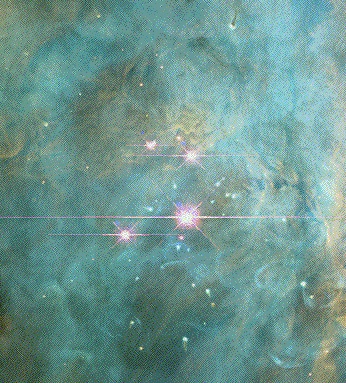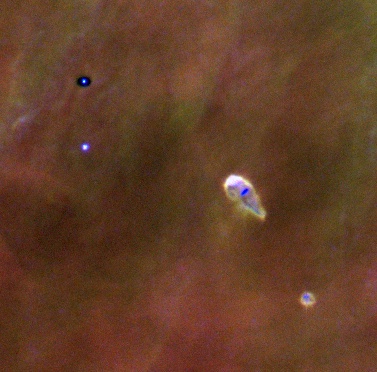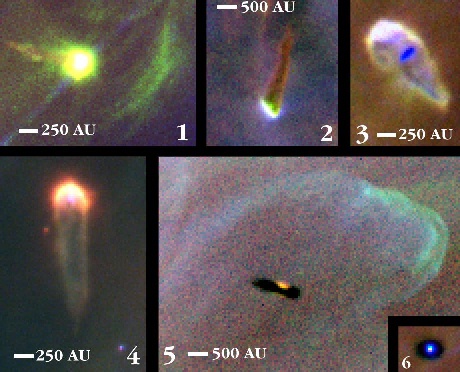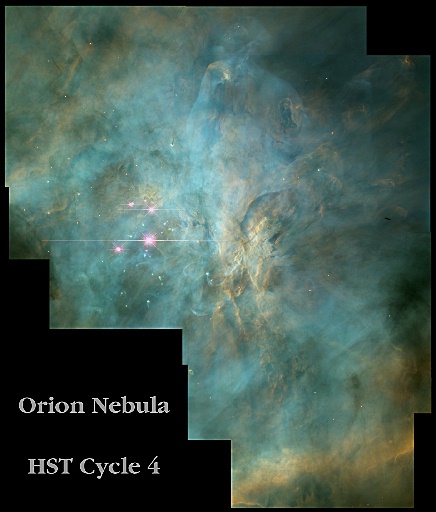The Orion Nebula M42
- 1. AAT Telescope
- 2. Hubble Space Telescope
- HST Mosaic of M42 region
- Detail
- Proplyds
- Research Detail
- Piercing the clouds with NICMOS
- 3. Subaru Telescope
This page was prepared from material from Doug Johnstone's Orion Nebula Research Page. It is presented here to indicate the depth of the research that is elucidating the processes occurring in the Orion Nebula.
Doug Johnstone
Orion Nebula Research
The following figures were part of a press release in 1997. The first two figures were included in the press kit and the others are included here for those who would like access for press purposes.
Scroll down through the images of the Orion Nebula taken with HST. Following each image is a descriptive figure caption and links for downloading the image for personal use. For futher information, contact Doug Johnstone.
 Figure 1: The core of the Trapezium showing the four energetic massive
stars and a plethora of Sun-like stars with surrounding extended emission.
The Trapezium is located in the center of the Orion nebula seen here as
a blue background glow. Note how the material surrounding the Sun-like stars
produces a cometary structure with a bright head and a tail pointing directly
away from the energetic central massive stars.
Figure 1: The core of the Trapezium showing the four energetic massive
stars and a plethora of Sun-like stars with surrounding extended emission.
The Trapezium is located in the center of the Orion nebula seen here as
a blue background glow. Note how the material surrounding the Sun-like stars
produces a cometary structure with a bright head and a tail pointing directly
away from the energetic central massive stars.
This false color mosaic, made
by combining multiple Hubble Space Telescope images, was presented to the
American Astronomical Society meeting in Toronto, Canada on January 14th, 1997.
PHOTO CREDIT: John Bally, Dave Devine, and Ralph Sutherland.
 Figure 2: A false color image of the teardrop shaped HST 10 star-disk system
and immediate neighbors, a silhouetted disk (top left) and a second star-disk
system (bottom right). At the center of HST 10 lies a dark nearly edge on
disk with a diameter
approximately the same as Pluto's orbit. Surrounding the system is diffuse hot
gas which has been evaporated from the disk surface. We are witnessing the
destruction of a circumstellar disk which if otherwise left alone would be
a strong candidate for producing planets.
Figure 2: A false color image of the teardrop shaped HST 10 star-disk system
and immediate neighbors, a silhouetted disk (top left) and a second star-disk
system (bottom right). At the center of HST 10 lies a dark nearly edge on
disk with a diameter
approximately the same as Pluto's orbit. Surrounding the system is diffuse hot
gas which has been evaporated from the disk surface. We are witnessing the
destruction of a circumstellar disk which if otherwise left alone would be
a strong candidate for producing planets.
This false color image, produced by combining three Hubble Space Telescope
images, was presented to the American Astronomical Society meeting in Toronto,
Canada on January 14th, 1997.
PHOTO CREDIT: John Bally, Dave Devine, and Ralph Sutherland.
 Figure 3: A gallery of star-disk systems in Orion's Trapezium. The first four
objects are being evaporated by the central massive stars, while the last
two disks are visible in silhouette against the background nebula.
Figure 3: A gallery of star-disk systems in Orion's Trapezium. The first four
objects are being evaporated by the central massive stars, while the last
two disks are visible in silhouette against the background nebula.
This false color image, produced by combining Hubble Space Telescope images, was presented to the American Astronomical Society meeting in Toronto, Canada on January 14th, 1997. PHOTO CREDIT: John Bally, Dave Devine, and Ralph Sutherland.
View hi res version of figure 3
 Figure 4: An extended view of the Trapezium showing the four energetic massive
stars and a plethora of Sun-like stars with surrounding extended emission.
The Trapezium is located in the center of the Orion nebula seen here as
a blue background glow. Note how the material surrounding the Sun-like stars
produces a cometary structure with a bright head and a tail pointing directly
away from the energetic central massive stars.
Figure 4: An extended view of the Trapezium showing the four energetic massive
stars and a plethora of Sun-like stars with surrounding extended emission.
The Trapezium is located in the center of the Orion nebula seen here as
a blue background glow. Note how the material surrounding the Sun-like stars
produces a cometary structure with a bright head and a tail pointing directly
away from the energetic central massive stars.
This false color mosaic, made by combining multiple Hubble Space Telescope images, was presented to the American Astronomical Society meeting in Toronto, Canada on January 14th, 1997. PHOTO CREDIT: John Bally, Dave Devine, and Ralph Sutherland.
View hi res version of figure 4
 Figure 5: The center of the Trapezium cluster showing the four massive energetic
stars and a number of evaporating proto-planetary disks.
Figure 5: The center of the Trapezium cluster showing the four massive energetic
stars and a number of evaporating proto-planetary disks.
This false color mosaic, made by combining multiple Hubble Space Telescope images, was presented to the American Astronomical Society meeting in Toronto, Canada on January 14th, 1997. PHOTO CREDIT: John Bally, Dave Devine, and Ralph Sutherland.
View hi res version of figure 5
This research was conducted by Doug Johnstone, currently an Assistant Professor in the Department of Astronomy at the University of Toronto, while an NSERC post-doctoral fellow at CITA, the Canadian Institute for Theoretical Astrophysics.
Scientific Papers:
- Photoevaporation of Disks and Clumps By Nearby Massive Stars: Application to Disk Destruction in the Orion Nebula, Johnstone, Hollenbach, and Bally 1988, ApJ, 499, 758. [abstract] - [pdf].
- Externally Illuminated Young Stellar Environments in the Orion Nebula: Hubble Space Telescope Planetary Camera and UV Observations, Bally, Sutherland, Devine, and Johnstone 1998, AJ, 116, 293. [abstract] [pdf]. Copies of individual figures from this paper are available from John Bally.
- Ultraviolet Radiation and Circumstellar Environments, Johnstone and Bertoldi for publication in The Orion Nebula Revisited (1998). [abstract]
- Destruction of Circumstellar Disks In Orion's Trapezium Explained, Press Release: (Released January 14th 1997 at 9:20a.m. EST) [Press Release]
In the period between 17 January 1997 and 23rd December 1999 when this material was downloaded, there had been
 visitors to the source page.
visitors to the source page.
Doug Johnstone's Scientific Home Page
Doug Johnstone's email address: johnstone@astro.utoronto.ca